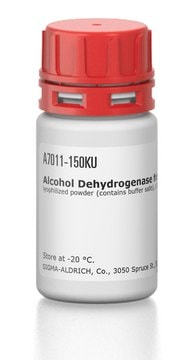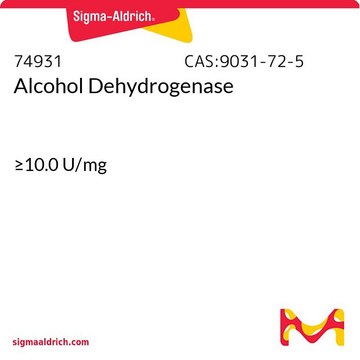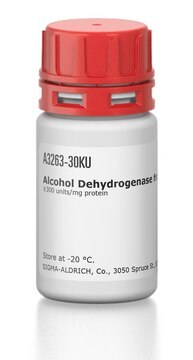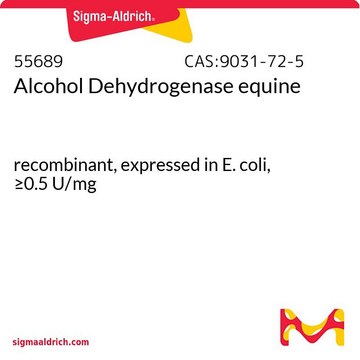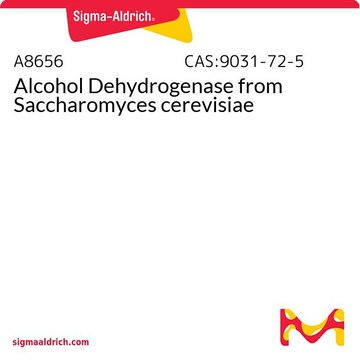49641
Alcohol Dehydrogenase, recombinant
≥500 U/mL
Sinónimos:
Alcohol:NADP+ oxidoreductase
Iniciar sesiónpara Ver la Fijación de precios por contrato y de la organización
About This Item
Número de CAS:
MDL number:
UNSPSC Code:
12352204
NACRES:
NA.54
Productos recomendados
recombinant
expressed in E. coli
Quality Level
form
liquid
specific activity
≥500 U/mL
technique(s)
cell based assay: suitable
color
light brownish-yellow to brown-green
suitability
suitable for molecular biology
application(s)
life science and biopharma
storage temp.
−20°C
¿Está buscando productos similares? Visita Guía de comparación de productos
General description
Research area: Neuroscience
Alcohol dehydrogenase has a homodimeric structure with a co-enzyme binding domain at the C-terminal and an N-terminal catalytic domain. The active site is located at the interdomain cleft. Binding of NAD+ in the active site causes conformational changes that create the binding site for the alcohol substrate.
Alcohol dehydrogenase has a homodimeric structure with a co-enzyme binding domain at the C-terminal and an N-terminal catalytic domain. The active site is located at the interdomain cleft. Binding of NAD+ in the active site causes conformational changes that create the binding site for the alcohol substrate.
Application
Alcohol dehydrogenase (ADH) has been used for the reversal of deficient 3-[4,5-dimethylthiazol-2-yl]-2,5 diphenyl tetrazolium bromide (MTT) assay reduction in the disrupted schizophrenia 1 (DISC1-FL) and DB7 cell lysate.
Biochem/physiol Actions
Alcohol dehydrogenase catalyzes the oxidative conversion of alcohol into aldehyde. The metabolism of ethanol catalyzed by alcohol dehydrogenase (ADH) results in the generation of reactive oxygen species (ROS) and nitric oxide (NO) leading to oxidative damage to mitochondria and cellular proteins and is further associated with the onset of neuroinflammation and neurological disorders.
Unit Definition
1 U corresponds to the amount of enzyme which reduces 1 μmol acetone per minute at pH 7.0 and 30°C (NADPH as cofactor)
signalword
Warning
hcodes
pcodes
Hazard Classifications
Eye Irrit. 2
Storage Class
10 - Combustible liquids
wgk_germany
WGK 3
flash_point_f
Not applicable
flash_point_c
Not applicable
ppe
Eyeshields, Gloves
Elija entre una de las versiones más recientes:
¿Ya tiene este producto?
Encuentre la documentación para los productos que ha comprado recientemente en la Biblioteca de documentos.
Structure of a triclinic ternary complex of horse liver alcohol dehydrogenase at 2.9 A resolution.
H Eklund et al.
Journal of molecular biology, 146(4), 561-587 (1981-03-15)
F Colonna-Cesari et al.
The Journal of biological chemistry, 261(32), 15273-15280 (1986-11-15)
A study of the hinge bending mode in the enzyme liver alcohol dehydrogenase is made by use of empirical energy functions. The enzyme is a dimer, with each monomer composed of a coenzyme binding domain and a catalytic domain with
H Eklund et al.
Biochemistry, 23(25), 5982-5996 (1984-12-04)
The binding of NAD to liver alcohol dehydrogenase has been studied in four different ternary complexes by using crystallographic methods. These complexes crystallize isomorphously in a triclinic crystal form which contains the whole dimer of the enzyme in the asymmetric
Tomáš Pluskal et al.
Nature plants, 5(8), 867-878 (2019-07-25)
Kava (Piper methysticum) is an ethnomedicinal shrub native to the Polynesian islands with well-established anxiolytic and analgesic properties. Its main psychoactive principles, kavalactones, form a unique class of polyketides that interact with the human central nervous system through mechanisms distinct
Albert Rosell et al.
Journal of molecular biology, 330(1), 75-85 (2003-06-24)
The amphibian enzyme ADH8, previously named class IV-like, is the only known vertebrate alcohol dehydrogenase (ADH) with specificity towards NADP(H). The three-dimensional structures of ADH8 and of the binary complex ADH8-NADP(+) have been now determined and refined to resolutions of
Nuestro equipo de científicos tiene experiencia en todas las áreas de investigación: Ciencias de la vida, Ciencia de los materiales, Síntesis química, Cromatografía, Analítica y muchas otras.
Póngase en contacto con el Servicio técnico